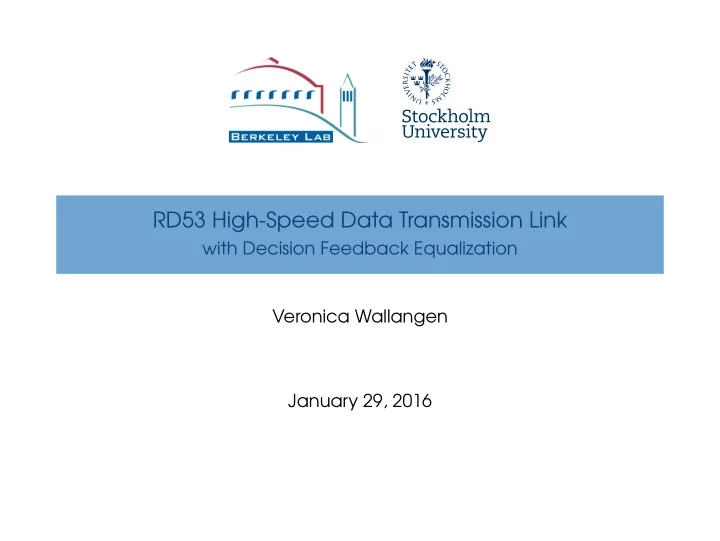

RD53 High-Speed Data Transmission Link with Decision Feedback Equalization Veronica Wallangen January 29, 2016
Channel Characterization design consisting of: January 29, 2016 RD53 High-Speed Data Transmission Link Veronica Wallangen (TWP) for on-stave transmission 2 / 9 chips needed by ATLAS and CMS at the HL-LHC ◮ RD53 collaboration: produce next generation of pixel readout ◮ Need pixel chip readout link: ◮ Currently studying different readout cable options for ITk upgrade ◮ Main requirements for electrical transmission lines: ◮ radiation hardness ◮ low mass ◮ high bandwidth: ≥ 5 Gbps ◮ Exploring prototype ”hybrid” cable ◮ 1m custom shielded twisted wire pair ◮ 6m twinax for off-stave transmission ◮ Design RD53 receiver circuit for use with ATLAS Phase-II pixel cables
S-parameter Measurements to voltage signals at each port to incident signal at port 1 attached directly to cable ends using 4-port VNA Veronica Wallangen RD53 High-Speed Data Transmission Link January 29, 2016 3 / 9 ◮ Cable characterization using S-parameters : describe response of network ◮ S 21 - transmission coefficient representing voltage detected at port 2 due ◮ Measure signal attenuation during transmission for wide frequency range using network analyzer ◮ RD53 chip: Differential signal output through 4-port device ◮ Measured S-parameters of hybrid cable with 50 Ohm SMA connectors
S-parameter Measurement Results Need for S-parameters? compensate for high-frequency signal errors account for data distortion in order to obtain a proper readout link design Veronica Wallangen RD53 High-Speed Data Transmission Link January 29, 2016 4 / 9 ◮ Generate SPICE model for hybrid cable to be used in simulations ◮ Achieving high data rates requires channel with low attenuation and distortion for noise reduction ⇒ Need feedback equalization to ◮ Industrial equalization technology not currently in use in HEP (use more primitive driver pre-emphasis) ⇒ more sophisticated solution needed ◮ S-parameters used to determine equalization needed at receiver end to
Signal Degradation caused by inherent low-pass transfer function signal smearing leaves trace of previous symbol in next symbol decoding SPICE modeling of hybrid cable Equalization essential to obtain higher speeds! Veronica Wallangen RD53 High-Speed Data Transmission Link January 29, 2016 5 / 9 ◮ Signal degradation in non-ideal channels characteristics ⇒ affecting amplitude, timing ◮ Intersymbol interference (ISI) at receiver end: ◮ I/O at 1 Gbps: ⇒⇒⇒ ◮ I/O at 5 Gbps:
Concept of Equalization curve that gives uniform requency response Veronica Wallangen RD53 High-Speed Data Transmission Link January 29, 2016 6 / 9 ◮ Compensation by RX equalization : removes ISI, restores signal integrity ◮ Solution to overcome frequency-dependent attenuation: highpass transfer ◮ Simple compensation idea: data processed through transfer function H − 1 ( s ) - ideally inverse of the cable transfer function H ( s )
properties of the channel Equalization Techniques Adaptive equalization w/ decision feedback precursors to take care of postcursors Veronica Wallangen RD53 High-Speed Data Transmission Link January 29, 2016 7 / 9 ◮ Many ways to implement equalizer based on communication channel ⇒ need for cable characterization ◮ Main categories: ◮ linear equalization (uses ”pre-decision”) ◮ adaptive equalization: automatically adapts to time-varying ◮ Decision Feedback Equalizer (DFE) : use decisions made on basis of ◮ idea: subtract smearing from previous bit
Motivation: Improved Signal Quality implemented (right) Veronica Wallangen RD53 High-Speed Data Transmission Link January 29, 2016 8 / 9 ◮ Eye diagram: overlaying of received bits on time axis ◮ Common indicator of signal quality in high-speed transmissions ◮ Ideal output: ◮ Sample eye diagram without RX equalization (left) and with equalization
Design Approach Test: Linear RX equalization January 29, 2016 RD53 High-Speed Data Transmission Link Veronica Wallangen 9 / 9 Berkeley Analog Generator (BAG) ◮ Simplest equalizer: differential pair with RC HPF ◮ Few parameters ⇒ yet time-consuming tuning! ◮ Collaborate with Berkeley Wireless Research Center: ◮ focuses on highly-integrated CMOS implementations ◮ expertise in current data transmission technology ◮ BAG tool: framework for automated analog integrated circuit design ◮ helps avoid repetitive tasks and circuit redesign ◮ integrates design flow steps into single environment ◮ produces input-specific optimized schematics and layouts ◮ Current status: awaiting NDA approval to access BAG
Recommend
More recommend